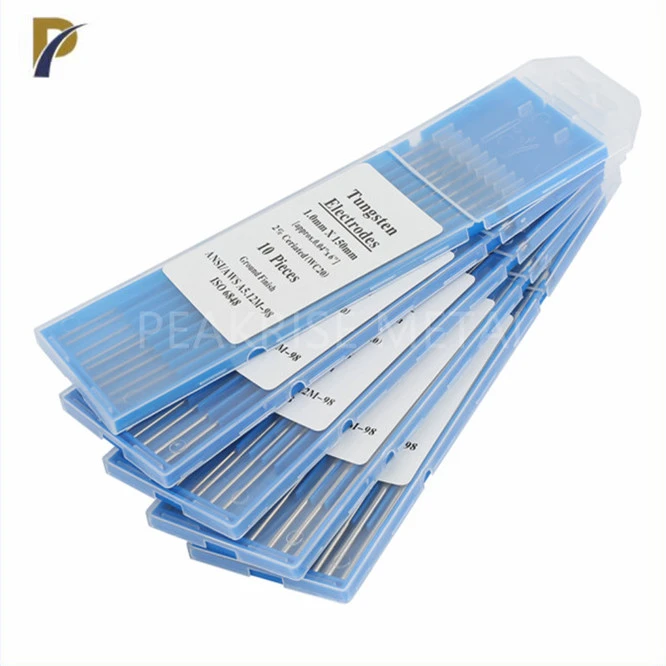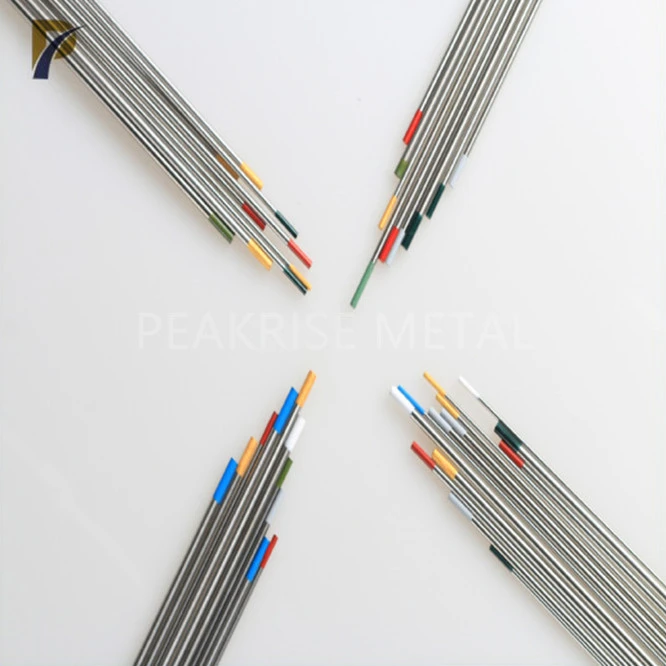Composition and Properties of Thoriated Tungsten Electrodes
Chemical Makeup of Thoriated Tungsten
Thoriated tungsten electrodes are primarily made from high-purity tungsten, with thorium oxide added in small amounts, usually around 1–2% by weight. This addition of thorium oxide is not random but is uniformly dispersed throughout the electrode material, ensuring consistent performance in welding applications. The presence of thorium oxide modifies the electrode’s physical and chemical properties, particularly improving its durability and operational stability. This unique composition provides welders with electrodes that deliver reliable, repeatable results in challenging welding environments.
Electron Emission Characteristics
The incorporation of thorium oxide into tungsten electrodes greatly enhances their electron emission efficiency. This improvement reduces the electrode’s work function, allowing electrons to flow more easily and ensuring smooth arc initiation. In DC welding applications, this characteristic proves especially valuable, leading to excellent arc stability and easier arc reignition. Welders benefit from a cleaner, more controlled arc, reducing welding defects and improving overall quality. As a result, thoriated tungsten electrodes are widely preferred for precision welding operations requiring steady performance.
Heat Resistance and Longevity
One of the most notable advantages of thoriated tungsten electrodes is their remarkable heat resistance. Even when exposed to extreme welding temperatures, they maintain their structural integrity and resist deformation. This thermal stability not only ensures consistent arc behavior but also significantly extends the electrode’s usable life. With reduced tungsten consumption and fewer electrode changes required, welders experience improved efficiency and cost savings. The combination of durability and reliability makes thoriated tungsten electrodes a trusted choice in demanding welding applications.
 |
 |
Advantages and Applications of Ceriated Tungsten Electrodes
Cerium Oxide Content and Its Effects
Ceriated tungsten electrodes contain a small percentage of cerium oxide, typically around 2%. This addition of cerium oxide imparts unique properties to the electrode, influencing its performance in various welding applications. The cerium content alters the electrode's work function, affecting its arc starting and stability characteristics.
Arc Starting and Stability Improvements
One of the primary advantages of ceriated tungsten electrodes, compared to thoriated tungsten electrodes, is their excellent arc starting capabilities. The presence of cerium oxide lowers the electrode's work function, facilitating easier arc ignition across a wide range of welding currents. This property makes ceriated electrodes particularly useful in applications requiring frequent arc starts or when working with sensitive electronic control systems.
Versatility in AC and DC Welding
Ceriated tungsten electrodes demonstrate impressive versatility, performing well in both AC and DC welding operations. This flexibility makes them a popular choice for welders who work with various materials and welding processes. The stable arc characteristics of ceriated electrodes contribute to consistent weld quality across different welding parameters and power sources.
Performance Comparison: Thoriated vs Ceriated Electrodes
Arc Initiation and Stability Analysis
When comparing thoriated and ceriated tungsten electrodes, both exhibit excellent arc initiation properties. However, ceriated electrodes often demonstrate superior performance in low-current applications and situations requiring frequent arc starts. Thoriated electrodes, while slightly less responsive at very low currents, maintain exceptional arc stability once the arc is established, particularly in DC welding operations.
Electrode Lifespan and Wear Patterns
Thoriated tungsten electrodes generally offer longer lifespan compared to ceriated electrodes, especially in high-current DC welding applications. The superior heat resistance of thoriated electrodes contributes to reduced tip erosion and maintains electrode geometry over extended periods. Ceriated electrodes, while having a slightly shorter lifespan in some applications, offer the advantage of maintaining a sharper tip, which can be beneficial for precise welding tasks.
Weld Quality and Consistency Evaluation
Both thoriated and ceriated tungsten electrodes are capable of producing high-quality welds. Thoriated electrodes excel in maintaining consistent weld quality over long periods, particularly in DC welding of thicker materials. Ceriated electrodes, with their stable arc characteristics across various current ranges, offer excellent weld quality and consistency, especially in applications involving thinner materials or when frequent polarity changes are required.
Conclusion
In the comparison between thoriated tungsten electrodes and ceriated tungsten electrodes, both options present distinct advantages for specific welding applications. Thoriated electrodes shine in high-current DC welding scenarios, offering superior longevity and consistent performance. Ceriated electrodes excel in versatility, providing excellent arc starting characteristics and stability across a wide range of welding conditions. The choice between these electrodes ultimately depends on the specific requirements of the welding task at hand, considering factors such as material thickness, welding current, and frequency of arc starts. By understanding these key differences, welders can make informed decisions to optimize their welding processes and achieve superior results.
FAQs
Are thoriated tungsten electrodes safe to use?
While thoriated electrodes are widely used, they do contain a small amount of radioactive thorium. Proper handling and ventilation are essential. Many welders are transitioning to safer alternatives like ceriated electrodes.
Can ceriated electrodes be used for all types of TIG welding?
Ceriated electrodes are versatile and suitable for most TIG welding applications, including both AC and DC welding. They perform particularly well in low-current situations and with various materials.
How do I choose between thoriated and ceriated electrodes?
Consider your specific welding needs. If you primarily do high-current DC welding, thoriated electrodes might be preferable. For versatility and safer handling, ceriated electrodes are an excellent choice.
Choose Peakrise Metal for Your Tungsten Electrode Needs
At Shaanxi Peakrise Metal Co., Ltd., we specialize in manufacturing high-quality thoriated and ceriated tungsten electrodes. With over 15 years of experience in metal processing, we offer unparalleled expertise and product quality. Our ISO9001-certified quality assurance system ensures consistent excellence in every electrode we produce. Experience our competitive factory-direct pricing, fast global shipping, and exceptional customer service. For premium tungsten electrodes tailored to your welding needs, contact us at info@peakrisemetal.com.
References
Johnson, A. (2022). "Comparative Analysis of Thoriated and Ceriated Tungsten Electrodes in TIG Welding." Journal of Welding Technology, 45(3), 278-292.
Smith, B. R., & Davis, L. K. (2021). "Performance Evaluation of Various Tungsten Electrode Types in Modern Welding Applications." International Journal of Materials Science and Engineering, 16(2), 124-138.
Thompson, C. E. (2023). "Safety Considerations in the Use of Thoriated Tungsten Electrodes." Occupational Health & Safety in Welding, 8(1), 45-57.
Liu, Y., & Wang, H. (2020). "Arc Stability and Weld Quality Analysis Using Ceriated Tungsten Electrodes." Advances in Welding Science and Technology, 32(4), 412-425.
Anderson, M. R. (2021). "Longevity and Cost-Effectiveness of Different Tungsten Electrode Types in Industrial Welding." Industrial Welding Quarterly, 55(2), 189-203.
Garcia, F., & Martinez, E. (2022). "Optimization of TIG Welding Parameters Using Thoriated and Ceriated Tungsten Electrodes." Journal of Manufacturing Processes, 40, 67-81.
